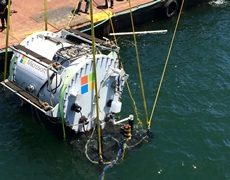Microsoft experiments with under-sea data centres to cut power bills
02 Feb 2016
Microsoft has tested a prototype of a self-contained data centre that can operate hundreds of feet below the surface of oceans, eliminating one of the technology industry's most expensive problems - the air-conditioning bill.
 Data centres are the large warehouses full of stacks of hard disks and processors that stay connected to the internet. All our images, videos and websites are available online because the data centres keep running 24x7. The only issue with these large rooms filled with computer hardware is the heat they produce.
Data centres are the large warehouses full of stacks of hard disks and processors that stay connected to the internet. All our images, videos and websites are available online because the data centres keep running 24x7. The only issue with these large rooms filled with computer hardware is the heat they produce.
If you thought your laptop had heating issues, try filling a baseball field with computers and running them all night. They generate enough heat to run the air conditioner bill high enough to actively look for a solution.
Google is trying to make data centres more energy efficient and cheaper to operate by setting them up on oceans - tidal energy for electricity and water for cooling the systems.
Microsoft is taking a more risky approach to solve the issue. It has decided to pack its entire data centre setup in a self-sufficient capsule and submerge it in the ocean.
The water will act as a coolant for the data centre and it will be hooked to a tidal energy harvester or turbines. Called Project Natick internally, Microsoft is exploring the idea of using the ocean-floor as viable real estate that has added benefits. For now, Microsoft is trying to make the assembly and deployment of these capsules faster.
The company recently completed a 105-day trial of a steel capsule eight feet in diameter that was placed 30 feet underwater in the Pacific Ocean off the Central California coast near San Luis Obispo. Controlled from offices on the Microsoft campus, the trial proved more successful than expected.
A diver went down monthly to check on the capsule; otherwise the research team remained in contact remotely. Data from the experiment was still being analysed but preliminary results appear promising, according to Microsoft.
''This is speculative technology, in the sense that if it turns out to be a good idea, it will instantly change the economics of this business,'' said Norm Whitaker, who heads special projects for Microsoft Research NExT.
''Deepwater deployment offers ready access to cooling, renewable power sources, and a controlled environment,'' Whitaker said.
The next phase of Project Natick is being planned and may include a bigger vessel with 20 times the computing power than the original, which is back at the Microsoft headquarters in Redmond, Washington.
Cloud computing lets people use the internet to tap into processing or data storage capacity at huge data centres. ''Businesses everywhere are using the Microsoft Cloud as their digital platform to drive their ambitious transformation agendas,'' chief executive Satya Nadella said during an earnings call. ''The enterprise cloud opportunity is massive.''
The capsule was named 'Leona Philpot' after a character in popular Xbox video game franchise 'Halo'.













.jpg)






.jpg)









